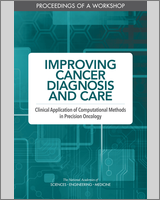NCBI Bookshelf. A service of the National Library of Medicine, National Institutes of Health.
A hallmark of high-quality cancer care is the delivery of the right treatment to the right patient at the right time. Precision oncology therapies, which target specific genetic changes in a patient’s cancer, are changing the nature of cancer treatment by allowing clinicians to select therapies that are most likely to benefit individual patients. In current clinical practice, oncologists are increasingly formulating cancer treatment plans using results from complex laboratory and imaging tests that characterize the molecular underpinnings of an individual patient’s cancer. These molecular fingerprints can be quite complex and heterogeneous, even within a single patient. To enable these molecular tumor characterizations to effectively and safely inform cancer care, the cancer community is working to develop and validate multiparameter omics tests and imaging tests as well as software and computational methods for interpretation of the resulting datasets. To examine opportunities to improve cancer diagnosis and care in the new precision oncology era, the National Cancer Policy Forum developed a two-workshop series. The first workshop focused on patient access to expertise and technologies in oncologic imaging and pathology and was held in February 2018. The second workshop, conducted in collaboration with the Board on Mathematical Sciences and Analytics, was held in October 2018 to examine the use of multidimensional data derived from patients with cancer, and the computational methods that analyze these data to inform cancer treatment decisions. This publication summarizes the presentations and discussions from the second workshop.
Contents
Suggested citation:
National Academies of Sciences, Engineering, and Medicine. 2019. Improving cancer diagnosis and care: Clinical application of computational methods in precision oncology: Proceedings of a workshop. Washington, DC: The National Academies Press. doi: https://doi.org/10.17226/25404.
Digital Object Identifier: https://doi.org/10.17226/25404
Additional copies of this publication are available from the National Academies Press, 500 Fifth Street, NW, Keck 360, Washington, DC 20001; (800) 624-6242 or (202) 334-3313; http://www.nap.edu.
Printed in the United States of America
- NLM CatalogRelated NLM Catalog Entries
- Review Clinical Application of Computational Methods in Precision Oncology: A Review.[JAMA Oncol. 2020]Review Clinical Application of Computational Methods in Precision Oncology: A Review.Panagiotou OA, Högg LH, Hricak H, Khleif SN, Levy MA, Magnus D, Murphy MJ, Patel B, Winn RA, Nass SJ, et al. JAMA Oncol. 2020 Aug 1; 6(8):1282-1286.
- Review Improving Cancer Diagnosis and Care: Patient Access to Oncologic Imaging and Pathology Expertise and Technologies: Proceedings of a Workshop[ 2018]Review Improving Cancer Diagnosis and Care: Patient Access to Oncologic Imaging and Pathology Expertise and Technologies: Proceedings of a WorkshopNational Academies of Sciences, Engineering, and Medicine, Health and Medicine Division, Board on Health Care Services, National Cancer Policy Forum. 2018 Sep 11
- The NCI All Ireland Cancer Conference.[Oncologist. 1999]The NCI All Ireland Cancer Conference.Johnston PG, Daly PA, Liu E. Oncologist. 1999; 4(4):275-277.
- Identifying Health Information Technology Needs of Oncologists to Facilitate the Adoption of Genomic Medicine: Recommendations From the 2016 American Society of Clinical Oncology Omics and Precision Oncology Workshop.[J Clin Oncol. 2017]Identifying Health Information Technology Needs of Oncologists to Facilitate the Adoption of Genomic Medicine: Recommendations From the 2016 American Society of Clinical Oncology Omics and Precision Oncology Workshop.Hughes KS, Ambinder EP, Hess GP, Yu PP, Bernstam EV, Routbort MJ, Clemenceau JR, Hamm JT, Febbo PG, Domchek SM, et al. J Clin Oncol. 2017 Sep 20; 35(27):3153-3159. Epub 2017 Jul 24.
- Review Opportunities and Challenges for Using Digital Health Applications in Oncology: Proceedings of a Workshop[ 2021]Review Opportunities and Challenges for Using Digital Health Applications in Oncology: Proceedings of a WorkshopNational Academies of Sciences, Engineering, and Medicine; Division on Engineering and Physical Sciences; Health and Medicine Division; Forum on Cyber Resilience; Board on Health Care Services; National Cancer Policy Forum, Nass S, Johnson AF, Balogh E. 2021 Aug 19
- Improving Cancer Diagnosis and CareImproving Cancer Diagnosis and Care
Your browsing activity is empty.
Activity recording is turned off.
See more...
